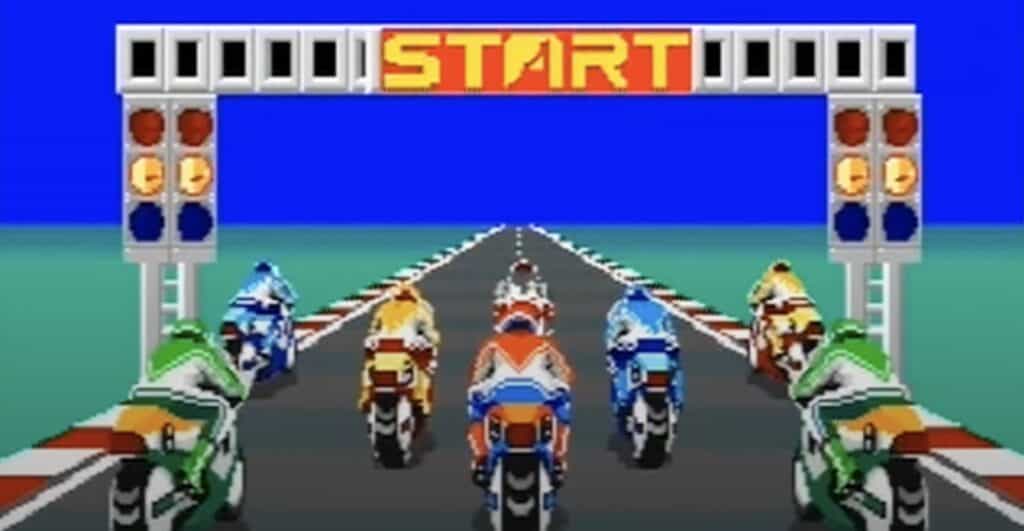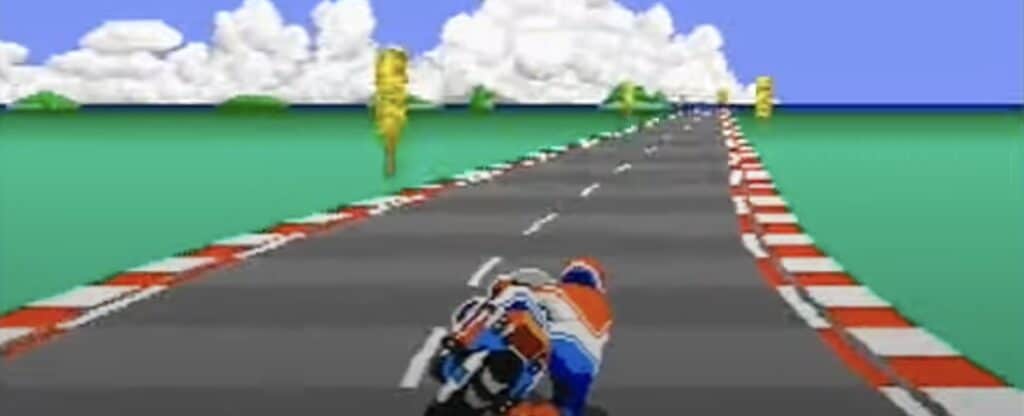Hang-On is a 1985 arcade racing game developed and published by Sega. Originally, Hang-On was created as a coin-operated arcade unit, but after its initial release, it received ports to consoles like the SG-1000, Sega Master System, MSX, and PC-88. Notably, Hang-On is one of the earliest video games with 16-bit graphics. The game uses the Super Scaler arcade system board, which mimics 3D effects. For the time, Hang-On had quite a few graphic advancements that other games like it did not have. The game’s designer, Yu Suzuki, modeled the game after world champion motorcycle racer, Freddie Spencer, a.k.a. Fast Freddie.
Getting ahold of an original Hang-On arcade unit costs a pretty penny today. Some Hang-On arcade units sell for well over $3,000. Fortunately, gamers have a few options if they want to play this retro racing game. My Abandonware has the Sega Master System version and the PC-88 version available to download. My Abandonware is a great resource for classic video games. It has a large catalog of retro games including titles like Tau Ceti (1985), Starquake (1985), and many more. Players can also find Hang-On on Classic Games Arcade where they can play it right on their internet browser.
At the time of Hang-On’s release, the game sold incredibly well. In 1985, it became the United States’ highest-grossing arcade video game. The following year, it maintained the title of highest-grossing arcade game in both the United States and Japan. Critics praised it for its graphics, realism, and the bike cabinet that allowed players to ride a fake bike to control the game. Hang-On is often credited for the motion simulator video games trend that grew in popularity in the late ’80s.
Hang-On Premise

©Zeusdaz – The Unemulated Retro Game Channel / Sega – License
Many classic video games, especially arcade games, didn’t have much in the way of plot, overarching story, or character development. Because the games were supposed to be fast-paced, single-sitting experiences, developers tended to cut to the chase and throw players right into the thick of the game. The gameplay always took priority over any other aspect of the game. Hang-On is no exception to this rule because it doesn’t feature an overarching story. Players simply play as a motorcycle racer competing in a tournament against other racers. Hang-On is a single-player game, so the other racers are computer-controlled opponents.
The player controls a single racer from behind the motorcycle perspective. The game features a linear track that is cut up into several sections. The player has a certain amount of time to finish the course. Most of the controls center around the lean mechanic. To turn the bike, players need to lean in the direction they want to go. The further they lean, the tighter the turn will be. Players can also accelerate the bike. Unfortunately, what made Hang-On such a fun game in the ’80s was the bike cabinet that allowed players to ride an actual bike. While the game is still playable today, it loses some of its charm without the bike cabinet. Racing game fans will probably still love Hang-On though.
If players reach the checkpoint at the end of one of the track sections, their time to complete the course will increase. Players get to keep any remaining time they have from one track to the next. The game works on a time-limited system, but players should still be mindful not to go off-course. If they crash, their character will fly off their motorcycle. There are five sections of the race track, so the game keeps going until the player completes every section or they run out of time.
Hang-On Main Characters
As mentioned, classic arcade games didn’t tend to focus on a complicated plot. Similarly, they often didn’t have any characters or development for the characters that did exist. Some classic games, like Space Invaders (1978), Thexder (1985), and TNK III (1985) had the player control a vehicle or non-organic vessel. For the time, this was common. Players controlled vehicles like tanks or spacecrafts. Sometimes they’d even control powered suits of armor or laser guns.
Hang-On does feature a playable character, a motorcyclist riding a motorcycle. Aside from the color of their bike and their gear, the character doesn’t have any unique features. Hang-On doesn’t elaborate on the character’s backstory or even name them. It just throws the player into the race. From the game’s development, we do know that the racing mechanics were inspired by Freddie Spencer, commonly known as Fast Freddie. Frederick Burdette Spencer is an American motorcyclist and former world champion. Since the game’s racing was based on his racing techniques, it’s safe to say that the playable character was created with Fast Freddie in mind.
Hang-On Titles in the Series
Hang-On was an innovative racing game of the mid-1980s. Not only did it popularize motion simulator games, but it also helped fuel the idea that Sega was one of the best developers in the gaming industry. The original Hang-On received multiple arcade unit versions and ports to home consoles. It also spawned a racing franchise that includes an even more recognizable game, Super Hang-On.
The Hang-On Series:
- Hang-On (1985) – The original arcade version
- Hang-On (1985) – Ports for home consoles: SG-1000, Master System, MSX, and PC-88
- Hang-On II (1985) – SG-1000
- Hang-On motorcycle cabinet (1986) – Motorcycle arcade cabinet version
- Hang-On Jr. (1986) – Arcade
- Super Hang-On (1987) – Sega Mega Drive/Genesis, Amstrad CPC, Commodore C64/128/MAX, Mac, ZX Spectrum, DOS, Wii, Sharp X68000, Atari ST/STE, PlayStation 3, Arcade, and Amiga
- Limited Edition Hang-On (1991) – Arcade
Hang-On Cheats, Cheat Codes, & Action Replay Codes

©Zeusdaz – The Unemulated Retro Game Channel / Sega – License
When Hang-On came out, the gaming industry looked very different from what modern gamers now expect. Games were short, usually couldn’t be saved, and threw players into the thick of the gameplay straight away. The difficulty of each game usually increased quickly as well, forcing players to play, die, try again, and likely die again. The trick to besting many of these games was practice. Players needed to rinse and repeat, familiarizing themselves with the gameplay. Practice makes perfect, so to speak.
That said, the difficulty of many of these quick-paced games didn’t go unnoticed. As a result, game developers often included exploits and cheats to make their games easier for anyone who wanted to use them. This allowed players to play the game authentically or implement cheats if they wanted an easier experience. Many cheats were game-breaking advantages, like activating slow motion, giving the player immortality, and infinite ammo.
Sadly, Hang-On doesn’t feature many ways to cheat. Popular websites gamers frequent for cheats and guides, like GameFAQs, don’t list anything for Hang-On cheats or exploits. If players Google “Hang-On video game cheats” almost every result that pops up is for the game Super Hang-On. Super Hang-On, as mentioned, is part of the Hang-On series, but it’s a different game and came out a few years after Hang-On.
Infinite Time Code
According to SMS Power, there is one Action Replay code for Hang-On. To use Action Replay codes, players must have access to the Action Replay cheat device and the corresponding consoles the device works with. Most modern players likely won’t have access to this, but if they do, this single code is incredibly useful.
- Infinite Time: 00C00D3C
- This means the timer will never go down. It will always display 59 seconds. Since Hang-On is based on a time limit, having infinite time is equivalent to having infinite lives.
Hang-On Cheats Cheats FAQ
If curious players Google “Hang-On video game cheats”, they’ll find a few frequently asked question results. Unfortunately, none of these results are relevant to the game in question. They all ask general questions about cheat codes. Just Googling “Hang-On video game” doesn’t produce any results either. For some reason, every FAQ result that comes up refers to Dig Dug, a 1981 arcade game created by Namco. Dig Dug has no relation to Hang-On whatsoever.
The image featured at the top of this post is ©Zeusdaz - The Unemulated Retro Game Channel / Sega.
